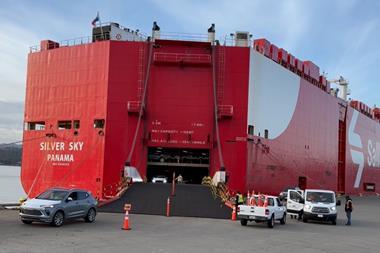
Despite ongoing weakness in the general European market for the sales and the shipping of cars, short-sea provider United European Car Carriers (UECC) will this month put a vessel currently in lay-up back into service, according to the company’s top management. The company has also revealed a significant improvement in bottom-line results for 2010 thanks largely to a strict management of its fleet capacity.
The revived vessel is a direct result of new business the company has gained for exports from Northern Spain, but is also thanks to rising volume for the Russian and Turkish markets as well as increases in high-and-heavy traffic.
“The justification for reactivating the vessel is because of new business from northern Spain to the north of the European continent,” said Craig Jasienski, UECC’s chief executive officer, during an interview with Automotive Logistics News in Oslo. “However, because of growth in Russia and Turkey, where we actually trade that vessel will be a question of fleet allocation.”
According to Björn O. Gran Svenningsen, head of car sales, Russia and Turkey remain the company’s only two real bright spots for the larger European region this year. Russia has seen its sales jump by around 50% since the summer months compared to 2009, although import growth has been weaker. Turkey, too, has seen substantial increases, with the domestic market roughly doubling, and export of light commercial vehicles – a key segment for UECC – showing strong growth.
High-and-heavy traffic, which now occupies about 10% of UECC’s cargo mix, has also improved significantly, up around 50% compared to 2009.
The restored ship will raise UECC’s current operational fleet to 17 vessels, with another two still in layup. With this the first increase in capacity since the downturn, UECC is running one of Europe’s most tightly controlled fleets. It reduced capacity more aggressively than most following the downturn in 2009. Prior to the crisis, the shipping line – owned by both Sweden’s Wallenius Lines and Japan’s NYK – had a fleet of 32 vessels. But in 2009 it cut this number in half by recycling five vessels, redelivering seven on time charter, selling two ships (which were converted to cattle carriers) and laying up a further three. Unlike some other shipping lines, the company currently has no new buildings scheduled to come into service, although its parent companies do.
The reduction was more than double the average cuts in capacity among asset providers for vehicle logistics in Europe, according to figures from the European Association of Vehicle Logistics (ECG). Some short sea carriers, according to Jasienski, have elected to continue running their entire fleet.
But the cut, part of a drive to readjust its network to run fuller vessels, has helped UECC improve its bottom line despite the feeble market and a lack of recovery in rates. Financials have improved “substantially” compared to last year, Jasienski said, even while volumes are lower by a few thousand units.
Unlike some deep-sea carriers, which took to slower steaming and increasing port calls to save on cost, for UECC this has not been possible, according to chief operating officer, Agustin Fernandez. “The OEMs used to be motivated by being top of the production charts, but now the pressure has increased enormously to deliver vehicles as soon as possible to reduce inventory costs,” he said. “This dynamic is more evident for short sea than deep sea.”
Despite removing the ship from lay-up, Jasienski believes the short sea market in Europe will still see some overcapacity. “Although it has firmed up from last year, we still see a degree of overcapacity,” he said. “There are operators still idling vessels, and we heard last week about one of our competitors selling a vessel in the Mediterranean, for example. There is also a question of new ships from Asia, and whether or not they will be allocated to Europe or not.
“We estimate that there will be still be about another one-and-a-half years of overcapacity,” Jasienski said.
The overcapacity, together with the weak market, has meant that rates remain low, said Jasienski. “The simple challenge we face is that these rates simply do not cover the cost of fuel or of building new ships. They are not sustainable.”
Svenningsen commented that while carmakers continued to put pressure on rates by going through new tenders to find lower costs, the main problem was that providers were still too willing to take on business at a loss. “It is we as an industry that continue to create this, in a way,” he said.
But UECC has also tried to avoid the worst pitfalls of the market by turning down non-profitable business, according to Fernandez. “We are trying to maintain market share but have recently seen some volumes decline where we said that we didn’t want to continue with money-losing operations,” he said.
And while the company stepped out of some admittedly high-volume contracts, the spot market and new business has helped to keep volume stable, while at the same time the bottom line has “significantly improved because the new business we have taken on is better”, said Jasienski.



































